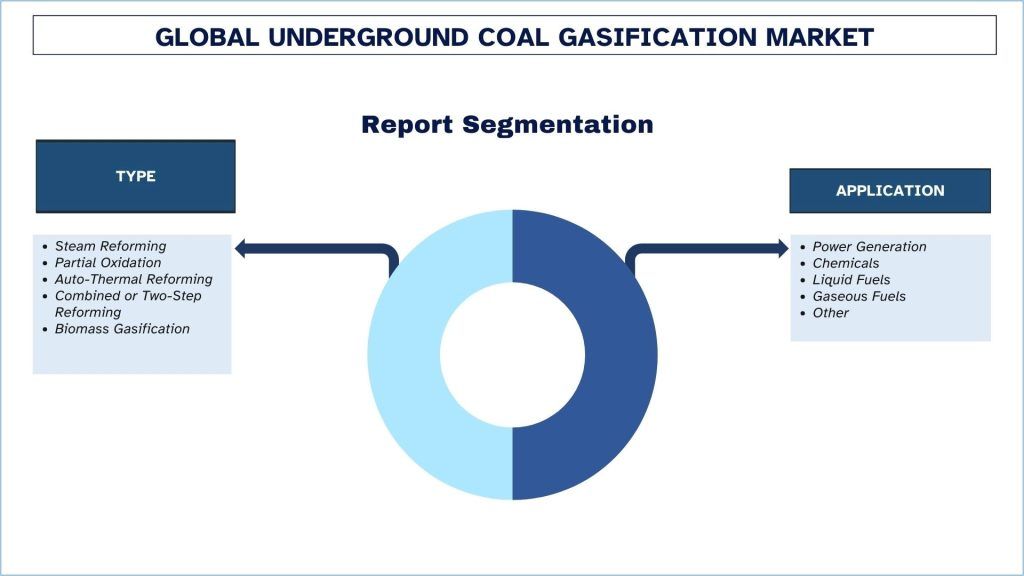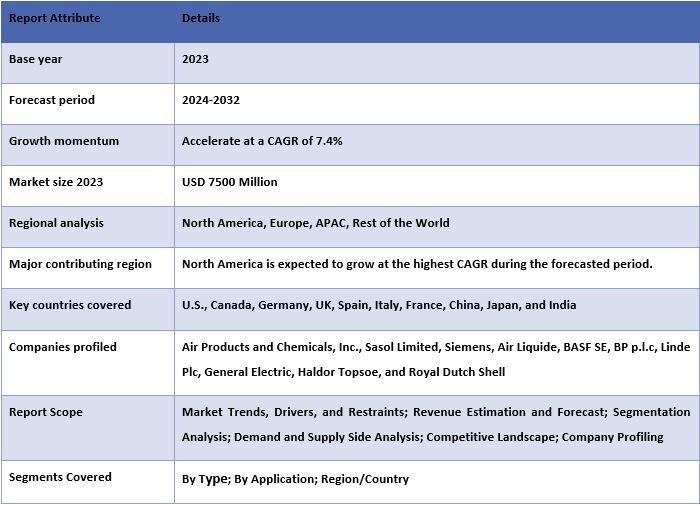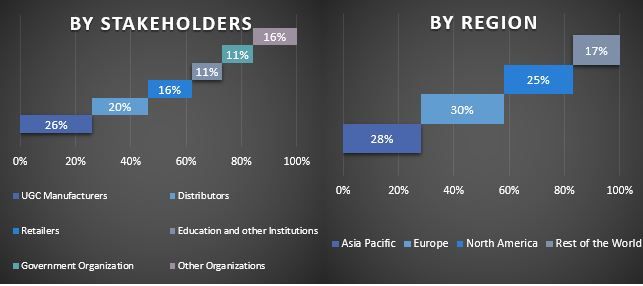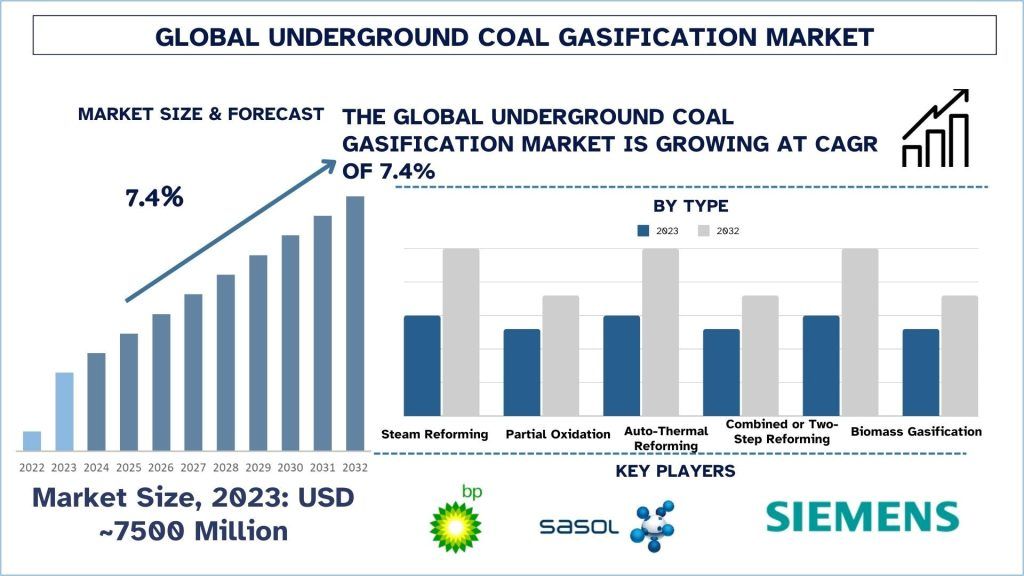- Home
- About Us
- Industry
- Services
- Reading
- Contact Us
Underground Coal Gasification Market: Current Analysis and Forecast (2024-2032)
Emphasis on Type (Steam Reforming, Partial Oxidation, Auto-Thermal Reforming, Combined or Two-Step Reforming, And Biomass Gasification); By Application (Power Generation, Chemicals, Liquid Fuels, Gaseous Fuels, and Others); Region/Country
Underground Coal Gasification Market Size & Forecast
The Underground Coal Gasification market was valued at USD 7500 Million in 2023 and is expected to grow at a CAGR of 7.4% from 2024-2032. Underground Coal Gasification (UCG) is the process of converting coal situated in the underground seam of the earth into synthesis gas or syngas which is a mixture of hydrogen, carbon monoxide, and methane. This process uses oxidants in the form of oxygen or air that is supplied at the coal deposit to ignite it and in turn create syngas using the combustion process. UCG is an unconventional method of mining that has the potential to assist with the objectives aimed at diminishing the conventional mining of coal since this process does not involve the actual physical digging and removal of coal from the ground. The produced syngas can be used in electricity generation, chemical making, and liquid fuels, thus providing an efficient way of tapping energy from coal with less pollution.
Underground Coal Gasification Market Analysis
Innovations such as Underground Coal Gasification (UCG) are being considered the next big thing in the utilization of coal that is more efficient and environmentally sound. As global energy requirements continue to grow, and as attempts are made to decrease the environmentally unfriendly effects of fossil fuel consumption, UCG can offer a more efficient and environmentally friendly alternative to conventional processes of coal mining and direct burning. The following section provides a comprehensive analysis of UCG’s global prospects based on several factors, including its regional activities, major market forces, prospects, risks, and trends over the coming years.
Underground Coal Gasification Market Trends
Advanced Drilling and Gasification Techniques: Modern trends in drilling and gasification technologies have enhanced the efficiency and safety of UCG. Technological advancements in the areas of directional drilling, the use of automatic robotic technology, and the use of real-time monitoring and control have made it possible to manage underground gasification risks.
Integration with Renewable Technologies: In the future, the UCG could be integrated with renewable energy sources to form a combined system that can deliver power supply for continual use. For instance, syngas derived from UCG could be stored to supplement renewable energy forms that are seasonal such as wind and solar energy.
Enhanced Monitoring Systems: Modern techniques such as 3D seismic imaging and higher-end sensors are now available that can enhance the safety and feasibility of UCG operations. These systems make it easier to regulate the degree of gasification, reduce the chances of subsidence or water pollution, and maximize the amount of energy that can be recovered from the coal seams.

Asia Pacific is Expected to Grow with Significant CAGR During Forecast Period
Asia Pacific has significantly contributed to the expansion of the Underground Coal Gasification market. China, India, and Australia, for instance, are endowed with widely distributed coal deposits; most of these deposits, however, are deep or otherwise inaccessible by conventional methods. UCG provides a feasible technique to exploit these otherwise inaccessible deposits and, therefore, is well suited for power generation in the region.
The practical implementation of UCG technology is being pioneered most actively in China because it needs to shift away from traditional coal burning, and pollution, and, at the same time, explore and utilize its abundant coal resources. The country is also experimenting with the utilization of UCG technology to resolve the issue of increasing energy demands in the country and to minimize the dependency of the country on imported fuels. Furthermore, there is now a shift towards decreasing greenhouse gas emissions and moving towards cleaner sources of energy, especially within the Asia-Pacific and hence there will be an added advantage for the UCG since CCS technology may be incorporated as a part of the process.
Underground Coal Gasification Industry Overview
- The Underground Coal Gasification market is competitive and fragmented, with the presence of several global and international market players. The key players are adopting different growth strategies to enhance their market presence, such as partnerships, agreements, collaborations, new product launches, geographical expansions, and mergers and acquisitions. Some of the major players operating in the market are Air Products and Chemicals, Inc., Sasol Limited, Siemens, Air Liquide, BASF SE, BP p.l.c, Linde Plc, General Electric, Haldor Topsoe, and Royal Dutch Shell.
Underground Coal Gasification Market Report Coverage

Reasons to buy this report:
- The study includes market sizing and forecasting analysis validated by authenticated key industry experts.
- The report presents a quick review of overall industry performance at one glance.
- The report covers an in-depth analysis of prominent industry peers with a primary focus on key business financials, product portfolios, expansion strategies, and recent developments.
- Detailed examination of drivers, restraints, key trends, and opportunities prevailing in the industry.
- The study comprehensively covers the market across different segments.
- Deep dive regional level analysis of the industry.
Customization Options:
The global Underground Coal Gasification market can further be customized as per the requirement or any other market segment. Besides this, UMI understands that you may have your own business needs, hence feel free to connect with us to get a report that completely suits your requirements.
Table of Content
Research Methodology for the Underground Coal Gasification Market Analysis (2024-2032)
Analyzing the historical market, estimating the current market, and forecasting the future market of the global Underground Coal Gasification market were the three major steps undertaken to create and analyze the adoption of Underground Coal Gasification in major regions globally. Exhaustive secondary research was conducted to collect the historical market numbers and estimate the current market size. Secondly, to validate these insights, numerous findings and assumptions were taken into consideration. Moreover, exhaustive primary interviews were also conducted, with industry experts across the value chain of the global Underground Coal Gasification market. Post assumption and validation of market numbers through primary interviews, we employed a top-down/bottom-up approach to forecasting the complete market size. Thereafter, market breakdown and data triangulation methods were adopted to estimate and analyze the market size of segments and sub-segments of the industry pertains to. Detailed methodology is explained below:
Analysis of Historical Market Size
Step 1: In-Depth Study of Secondary Sources:
A detailed secondary study was conducted to obtain the historical market size of the Underground Coal Gasification market through company internal sources such as annual reports & financial statements, performance presentations, press releases, etc., and external sources including journals, news & articles, government publications, competitor publications, sector reports, third-party database, and other credible publications.
Step 2: Market Segmentation:
After obtaining the historical market size of the Underground Coal Gasification market, we conducted a detailed secondary analysis to gather historical market insights and share for different segments & sub-segments for major regions. Major segments are included in the report as type and application. Further country-level analyses were conducted to evaluate the overall adoption of testing models in that region.
Step 3: Factor Analysis:
After acquiring the historical market size of different segments and sub-segments, we conducted a detailed factor analysis to estimate the current market size of the Underground Coal Gasification market. Further, we conducted factor analysis using dependent and independent variables such as type, and application of the Underground Coal Gasification market. A thorough analysis was conducted of demand and supply-side scenarios considering top partnerships, mergers and acquisitions, business expansion, and product launches in the Underground Coal Gasification market sector across the globe.
Current Market Size Estimate & Forecast
Current Market Sizing: Based on actionable insights from the above 3 steps, we arrived at the current market size, key players in the global Underground Coal Gasification market, and market shares of the segments. All the required percentage shares split and market breakdowns were determined using the above-mentioned secondary approach and were verified through primary interviews.
Estimation & Forecasting: For market estimation and forecast, weights were assigned to varied factors including drivers & trends, restraints, and opportunities available for the stakeholders. After analyzing these factors, relevant forecasting techniques i.e., the top-down/bottom-up approach were applied to arrive at the market forecast 2032 for different segments and sub-segments across the major markets globally. The research methodology adopted to estimate the market size encompasses:
- The industry’s market size, in terms of revenue (USD) and the adoption rate of the Underground Coal Gasification market across the major markets domestically
- All percentage shares, splits, and breakdowns of market segments and sub-segments
- Key players in the global Underground Coal Gasification market regarding products offered. Also, the growth strategies adopted by these players to compete in the fast-growing market.
Market Size and Share Validation
Primary Research: In-depth interviews were conducted with the Key Opinion Leaders (KOLs) including Top Level Executives (CXO/VPs, Sales Head, Marketing Head, Operational Head, Regional Head, Country Head, etc.) across major regions. Primary research findings were then summarized, and statistical analysis was performed to prove the stated hypothesis. Inputs from primary research were consolidated with secondary findings, hence turning information into actionable insights.
Split of Primary Participants in Different Regions

Market Engineering
The data triangulation technique was employed to complete the overall market estimation and to arrive at precise statistical numbers for each segment and sub-segment of the global Underground Coal Gasification market. Data was split into several segments & sub-segments after studying various parameters and trends in the areas of type, and application in the global Underground Coal Gasification market.
The main objective of the Global Underground Coal Gasification Market Study
The current & future market trends of the global Underground Coal Gasification market were pinpointed in the study. Investors can gain strategic insights to base their discretion for investments on the qualitative and quantitative analysis performed in the study. Current and future market trends determined the overall attractiveness of the market at a regional level, providing a platform for the industrial participant to exploit the untapped market to benefit from a first-mover advantage. Other quantitative goals of the studies include:
- Analyze the current and forecast market size of the Underground Coal Gasification market in terms of value (USD). Also, analyze the current and forecast market size of different segments and sub-segments.
- Segments in the study include areas of type and application.
- Define and analyze the regulatory framework for the Underground Coal Gasification
- Analyze the value chain involved with the presence of various intermediaries, along with analyzing customer and competitor behaviors of the industry.
- Analyze the current and forecast market size of the Underground Coal Gasification market for the major region.
- Major countries of regions studied in the report include Asia Pacific, Europe, North America, and the Rest of the World
- Company profile of the Underground Coal Gasification market and the growth strategies adopted by the market players to sustain in the fast-growing market.
- Deep dive regional level analysis of the industry
Frequently Asked Questions FAQs
Q1: What is the current market size and growth potential of the Underground Coal Gasification market?
Q2: What are the driving factors for the growth of the Underground Coal Gasification market?
Q3: Which segment has the largest share of the Underground Coal Gasification market by application?
Q4: What are the emerging technologies and trends in the Underground Coal Gasification market?
Q5: Which region will dominate the Underground Coal Gasification market?
Related Reports
Customers who bought this item also bought











